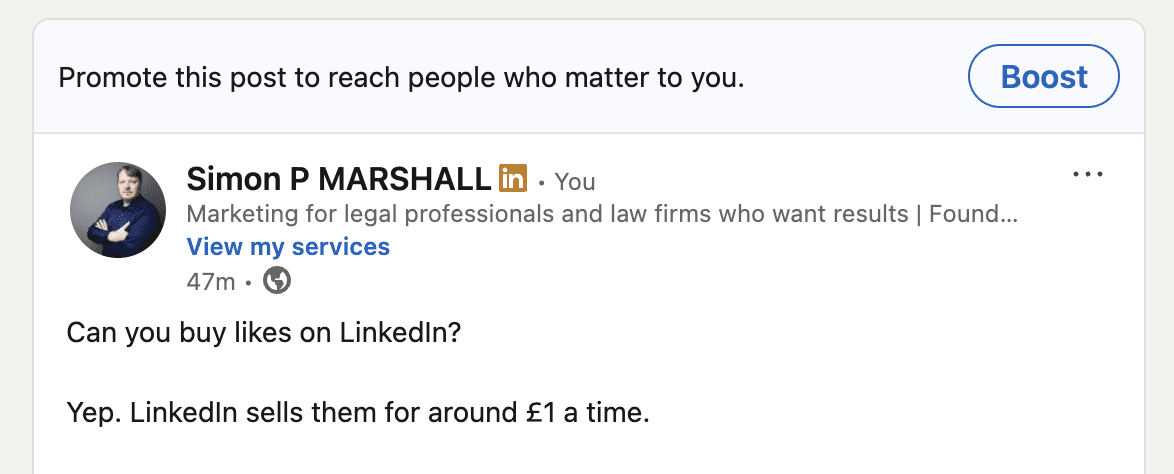This week, I am handing the editorial reins over to TBD’s youngest team member, Jacob Nomafo. A “certified memeologist” and a member of Gen Z, Jacob is our resident expert when it comes to using social media in novel ways that connect with both a Gen Z and Gen X audience.
Despite his youth, Jacob can already boast an impressive resume: he played a key role in driving the success of the 10,000 Black Interns programme as its social media manager; was instrumental in garnering media interest in the ForThe100 campaign (where our paths crossed); and is also the co-founder and CEO of humour-driven social media marketing agency Lucid Meme.
In this special takeover edition, Jacob delves into the dynamic at work when Gen Z manages the social media account of Gen X – as is the case in many of the UK’s top law firms – and the things that Gen Z need to be aware of when it comes to understanding the concerns of their older colleagues (and vice versa).
Take it away, Jacob!
Managing Gen X’s feed when you’re Gen Z – by Jacob Nomafo
Having worked in B2B and B2C marketing for over six years, from my time at Red Bull to working with clients as a social media and comms consultant, I’ve always found the way in which social media has evolved to be fascinating. Technology has progressed more in the past 20 years than ever before, changing how we live, travel and communicate.
Social media, holding the fort on the communication front, has redefined the social fabric of society and fundamentally changed the way we interact as humans. What’s more true today than ever is that social media changes… fast. From daily trends to weekly algorithmic updates, there’s a lot to keep up with (and keeping up is a constant challenge).
For Gen Z, born between 1997 and 2012, having grown up alongside platforms such as Facebook (founded in February 2004) and Twitter/X (founded in March 2006), social media has always been a part of our lives (for better or for worse). As a result, we have a natural propensity to lean into this constant tide of change in which the raw, candid and agile ways we use social media reflects.
Because of this, many of us have found ourselves working in roles where we run, manage or promote social media. It feels approachable and something we understand naturally, as it’s something we’ve always known. Across the spectrum of the different social media roles out there, a common position today is personal branding and ghostwriting. More specifically, managing a personal page on behalf of an older colleague, likely a Gen X’er.
Gen X, born between 1965 and 1980, generally use social media differently; they are stylistically traditional and often have a more reserved approach, contrasting with that of Gen Z. When working together, the disparities between these two generations are likely to lead to some interesting (and at times challenging) conversations.
Our motives, as Gen Z’ers, are pure. We want the best results and know we need to bring a bit of ourselves into the role to deliver the best possible outcome. The problem is that the only real way to grow on social media is by testing out new things, which can be challenging for those who are born a generation or more before us to submit to, because they already have established relationships and networks forged in real life. As a consultant who has worked closely in training Gen X and managing some of the outputs, I know from experience that we have to communicate objectives and tactics and get it right from the get-go. In facing the challenges as a Gen Z managing an older colleague’s page, the key is to blend formats from both your world and theirs. We have to make it safe for them to take each step.
Let’s dive into the best way to approach things.
Gen Z: Firstly… why are we even talking about this?
Gen X: Overview
Timing is important. For Gen X, social media came into the world way after they reached adulthood. They already had their tried and tested ways of doing things in life, and have established what works best for them (both personally and professionally). The benefit of this is that technology didn’t dictate their lives, and they were able to work alongside it. For Gen Z, the rise of social media couldn’t have interrupted our developmental years more. Social media influenced our upbringing and became a lens through which we interpret the world and through which we live.
If you’re reading this blog in a public place, look up and around: I’m almost certain you’ll see someone on their phone, likely on social media. It has changed the social fabric of society, and we’re spending more time online than ever before. Social is a shared space for all, so when managing an account on behalf of someone within your organisation, particularly those in leadership positions, it’s important to have a clear strategy (and tone of voice) that underpins all posts and engagements, aligning with both generational approaches.
It’s a combination of content that works for them as individuals but is also likely to perform on the platforms.
Both generations have used, and will always use, these platforms in different ways. It’s important to keep these differences in mind, as they inform how we best navigate the idea of bringing new ideas to the table.
As Gen Z, what may seem like the right thing to do is to directly mimic your Gen X colleagues’ presence, and distance yourself from the ways you normally use social media. This is not the way to go about things: there is a much better way.
Gen Z: So… how do I manage a Gen X’s feed as a Gen Z?
Gen X: The Process
So, how does a Gen Z effectively manage a Gen X’s page? Ultimately, (much like the best ever line to say on any Zoom call, ***drumroll please***) It’s just about finding the right balance.
In understanding this balance, let’s look at what both generations don’t have in common when it comes to social media by understanding the disparities between content formats generally used by the different generations:
*Disclaimer, this split is intentionally stark for clarity: things are not this black and white.

Generally speaking, Gen X’s approach to social media can be seen as traditional and leaning into the modern alternatives of classic communications – a more calculated and reserved form of usage.
In the case of Gen Z, we have a much more candid approach, and will use formats that allow for this openness, with a more honest and blunt feel.

The best way to manage a page for Gen X is to create a mixed feed – blending content types from the left and right sides of the diagram.
In practice, the goal is to work with Gen X to move the content from the left of the diagram, towards the centre, then rightward. Then, over time, once they are more comfortable, we can begin to operate the page (or profile) from the centre, and dip into the left and the right sides. The benefit of having a mixed feed is that experts and thought leaders can speak to multiple audiences at once.
Creating clear groupings means you can segment what each piece of content is for, and who it’s for. I always advise my clients to ask themselves the following questions: Who is this post for? What does it speak to? What do they know before they read the post? What do you want them to feel after they’ve engaged with it? This way, your content speaks to a broader range of people for different reasons, with the specific targeting of the different groups complementing one another.
If you are at the helm of a Gen X page or profile and you have been mandated to facilitate change because your company wants growth (and you know we need to find the balance to get there), then you must lay out this approach in a logical way that aligns with the commercial strategy of the business. Most of the issues you will encounter are around communicating the unpredictability of social media, so you need ways of getting it down on paper to slide across the table for approval.
First, you need to define that balance and map things out. Here’s an example of what a balanced calendar looks like (using elements from the diagram), which you could put forth:
Week 1:

Week 2:

Gen Z: It’s easier said than done, though, let’s be real
Gen X: Assessing Practicalities
We want to work with our Gen X colleagues to shift rightward across the diagram, but how can you convince them that this is the right thing to do? These can be hard conversations; many things in social happen ‘just because’. This isn’t a good nor a logical explanation – in these times, it’s essential to be flexible, look past your perspective and see social media through their lens. The key is to maintain this duality in your approach, considering the best of your perspective and your colleague’s.
I recommend you consider the following points when consulting with the people who you advise and support:
When testing new content types: Make sure you consistently inform them of the importance of testing, and how social media is all about testing to find what works. Use examples of other people in the same industry who have experimented with new content types and base your ideas on the framework of their content. Not the content itself but the approach and format of those successful posts.
The question of risk: Gen X might think memes, for example, are risky. The fact is that any post could be risky. It’s not about the format, it’s about the messaging. Exploring new formats doesn’t bring the risk; continually doing things the traditional way on social media is arguably where the risk lies. You don’t want yourself or the business you work for to appear outdated as a result of the wrong approach.
Recruitment and retention: If you are looking to attract (and retain) a next-gen workforce, organisations and leaders need to maintain this duality of content. Why? The page and person represent the company, and to effectively recruit you need to make content that people see themselves in. Spoiler alert: this doesn’t come from blocks of text. This comes from reflecting the environment young talent aspires to be a part of, in formats they use and understand.
Reactivity: This is a trait of how Gen Z have always approached social media; it is important to always leave slack for reactive content. Work with the person whose page you’re managing to create structures to facilitate this reactivity, and ease them into being more agile in their approach to content planning.
Gen Z: Final words of advice (if you take anything away, take this)
Gen X: Conclusion
Like many things, the effective management of a Gen X’s page as Gen Z requires a tentative approach. This is a Goldilocks situation and we need to help Gen X experience and understand the full spectrum of content diversity.
I recommend that you keep these three points in mind:
- Content needs to be intentional, yet authentic. Be clear on exactly who each piece of content is aimed at. With a blended format, you are appealing to different audiences for different reasons, so keep them segmented and your intentions for each clear.
- Sometimes there is no logical explanation to offer your Gen X colleague for doing something. As we all know, lots of things go well in social for no particular reason; often it can only be described as a feeling. Tapping into this feeling requires distancing oneself from logic, which is normal and acceptable for Gen Z. Spend time thinking about how to best communicate this to your Gen X colleagues to justify the rationale behind your decision-making.
- Rome wasn’t built in a day. Change has to come gradually, informed by the real-time evolution of the social media landscape. The progression has to feel natural; ease your colleagues into introducing and blending content types. With each small increment towards the centre of the diagram you take, don’t just do it for the sake of it, but make sure each move is purposeful, explainable and smart.
There is no one-size-fits-all way to approach social media, especially in this context. It’s for you to feel out, but hopefully the above will make that process more seamless.
In other news
More small firms charting a course for growth using legal tech
According to a new survey conducted by LexisNexis, there is a newfound confidence in the smaller end of the legal market, with a 57% increase in firms planning to grow organically in the next five years compared to 12 months ago. Legal tech represents the top area of investment to help these firms achieve their growth targets.
Fine for defence lawyer over rape survivor questioning
This week, BBC News reported on the case of Ellie Wilson, a rape survivor who successfully took her rapist to court and also took action against her rapist’s defence lawyer Lorenzo Alonzi, who, according to a Faculty of Advocates committee, “repeatedly crossed line” while questioning Ms Wilson in court. Alonzi’s behaviour amounted to unsatisfactory professional conduct on six of the 11 issues raised, the committee found, and stated that he did not appear to clearly and unequivocally accept any wrongdoing or offer an unreserved apology.
Open AI receives a Scarlett letter
Several news outlets, including BBC News and Wired, this week reported on Hollywood actor Scarlett Johansson’s blistering response to the launch of Open AI’s new conversational ChatGPT interface, which initially featured a voice eerily reminiscent of the AI assistant played by Johansson in the sci-fi movie Her, but then had the voice module suddenly disabled over the weekend.
On course for an historic first at the Law Society?
On Thursday, The Times reported that friend of TBD Dana Denis-Smith is in the running to become the eighth female president of the Law Society – and the first foreign-born person to steer the fortunes of this august institution. It’s great news, and we’ll all be keeping our fingers crossed here at TBD; but even greater is the feline-themed LinkedIn post put out by Dana’s business Obelisk Support to announce the news!
I hope you’ve enjoyed this week’s edition.
Thanks,
Si Marshall






